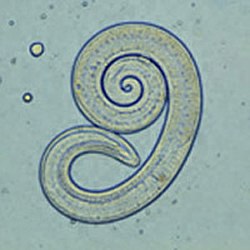| Trichinellidae | |
|---|---|
 | |
| Trichinella spiralis larva | |
| Scientific classification | |
| Kingdom: | Animalia |
| Phylum: | Nematoda |
| Class: | Enoplea |
| Order: | Trichocephalida |
| Family: | Trichinellidae |
| Genera [1] | |
Echinocoleus Lopez Neyra, 1947 | |
The family Trichinellidae includes the genus Trichinella . [1]
Trichinella species, which are also known as trichina worms, are responsible for the disease trichinosis. [2]